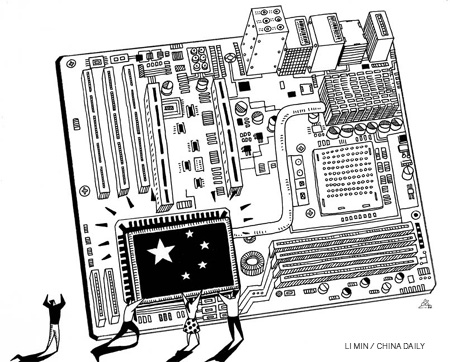Opinion
Anti-China allegations reveal old mindset
By Xu Li (China Daily)
Updated: 2010-08-17 14:56
 |
Large Medium Small |

Even before the tide of criticism against China's currency rate could recede, Washington has questioned Beijing's technology innovation policy. In the US Chamber of Commerce report on China's industrial policies, American trade officials have censured China's indigenous innovation policy. The US chamber says China's technology innovation policy is either forced technology transfer or technology theft.
By defining indigenous innovation as enhancing original innovation through co-innovation and/or re-innovation based on the assimilation of imported technologies, China negates autarky and adopts an open stance toward building its technological capacity on existing technologies, domestic and foreign both. Yet the US views this as China's intention to dominate the world and wrest the global leadership from other countries (mainly the US).
The US chamber report shows what the Americans are most worried about is China's hi-tech move, which Washington thinks is based upon foreign investment in the country, government procurement, compulsory licensing of patents and improvement of existing foreign patents.
WTO rules help us address US concerns. When China was admitted to the WTO, it vowed never to use technology transfer as a condition for investment in the country. China's laws have honored that commitment. Though China is not yet a signatory to the Government Procurement Agreement, when it comes to government procurement, it promises to offer the most-favored-nation status to other countries.
WTO rules on intellectual property rights' protection provide conditions for compulsory licensing, and China has made several amendments to its laws to conform to international rules. Besides, there hasn't been a really serious licensing case in China. What could then make the US say China's new technology development approach is technology theft?
The fact is that improvisations are prevalent across the world. The WTO recognizes a second patent (on an improvisation) if it is an important, technically advanced form with considerable economic significance compared with the first patent.
When China obtains technology from foreign entities, it offers them access to the country's markets according to WTO rules. Yet foreign countries accuse China of transferring technology forcibly from foreign suppliers and not keeping its promises of opening up its market.
We have to step back from the dispute to see the bigger picture of an old order or balance in the technology trade, in which China has paid a huge amount of royalties for technology import and that the US is still suffocating China by restricting on hi-tech exports to the country. China's indigenous innovation will no doubt affect the old order and tip the old balance as technology exporting countries, more or less, lose their leverage in the market. And if they cannot rebalance the situation by adjusting their domestic policies, they will only end up complaining against and criticizing others.
Ironically, the countries that accuse China of malpractice are the ones that have the greatest stake in China. No wonder, any industrial move by China makes them alert. In essence, the fresh accusations against China's technology development plans reflect the China-threat theory that the US and some other Western countries have been propagating for long.
Contrary to what the US Chamber of Commerce says, China is far from being a leader in enacting international rules. This is evident in the anti-China provisions in international trade rules. What we can foresee is the complaining countries invoking international rules to rebuke and restrict China's technology policies. But this is not new, as proved by the years-old anti-China trade measures to curb its exports and the hue and cry over the yuan's exchange rate.
Since China, to a large extent, reserves its government procurement and services markets, it can and needs to develop its technology according to WTO rules. Else, Chinese industries may be dwarfed once the country's markets open up fully.
China understands the sense of urgency and crisis reflected in the US chamber report. Yet since the WTO rules haven't fully pried open the government procurement and services markets, a proper approach for the complainants would be to drop their stereotyped notions and cynical criticism of China's technology innovation policy. Instead, they should view the entire process from a development perspective and engage in talks with China in order to build mutual understanding and trust.
The author is director of Policy Review Division of WTO Affairs Center in Beijing.



